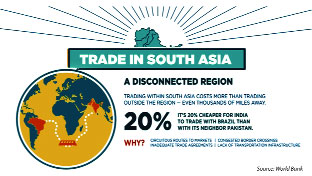
Working towards a closely knit region
Jahangir Bin Alam | Tuesday, 22 November 2016

Boosting trade and connectivity between Bangladesh and India, especially the people-to-people contact, was at the centre of Indian Prime Minister Narendra Modi's last visit to Dhaka. During the visit, both countries were keen to enhance connectivity not just between the two, but also with other countries in South Asia. The BBIN (Bangladesh, Bhutan, India and Nepal) corridor was high on the agenda during the visit. Indeed, Bangladesh is an important conduit for India's 'Act East' Policy. It is time to emphasise the role of India's northeast in warming the ties between the two countries.
The primary means of connectivity denotes physical connectivity by road and railways as well as waterways including inland and sea routes. Connectivity also has its potential in exploring collaboration in the field of energy (gas, electricity and hydropower), coordination in border management to facilitate movement of people across the border states (through tourism, local trade, border haats or markets etc.) and the institutional and administrative mechanisms are also necessary for boosting connectivity.
Border markets are helping establish the people-to-people contacts, mainly between Bangladeshis and the people of North Eastern states of India. More and more tourism and cultural exchanges could help promote the people-to-people contacts further.
Likewise, educational and sports-related exchanges can play a significant role in enhancing the people-to-people contacts between the two countries and the countries of the South Asian sub-region.
Train and bus services are important modes for improvement of the people-to-people contacts, especially for middle and lower middle classes of the population.
For strengthening political and cultural ties to foster economically-beneficial associations, 'connectivity' has become a buzzword in recent years.
In the wake of globalisation, strengthening regional and sub-regional cooperation is widely appreciated and acknowledged at all levels. Keeping these facts in view, the issue of connectivity among Bangladesh, the northeastern states of India and our southeast Asian neighbours, including Myanmar and Thailand, in addition to China, necessitates due attention of the governments concerned of the region.
There is no denying the fact that improvement of connectivity is the key to ensuring regional security and development. Connectivity may provide the transmission channels, through which development impulses can spread across the region and can add to the augmentation of economic and social progress of the countries in the region.
Recent initiatives of the governments of both Bangladesh and India towards improvement of rail, road and waterway connectivity will go a long way in enhancing bilateral trade between the two countries in general and people to people contacts, in particular.
The writer is secretary and CEO of
India-Bangladesh Chamber of
Commerce and Industry.
jbalam44@yahoo.com